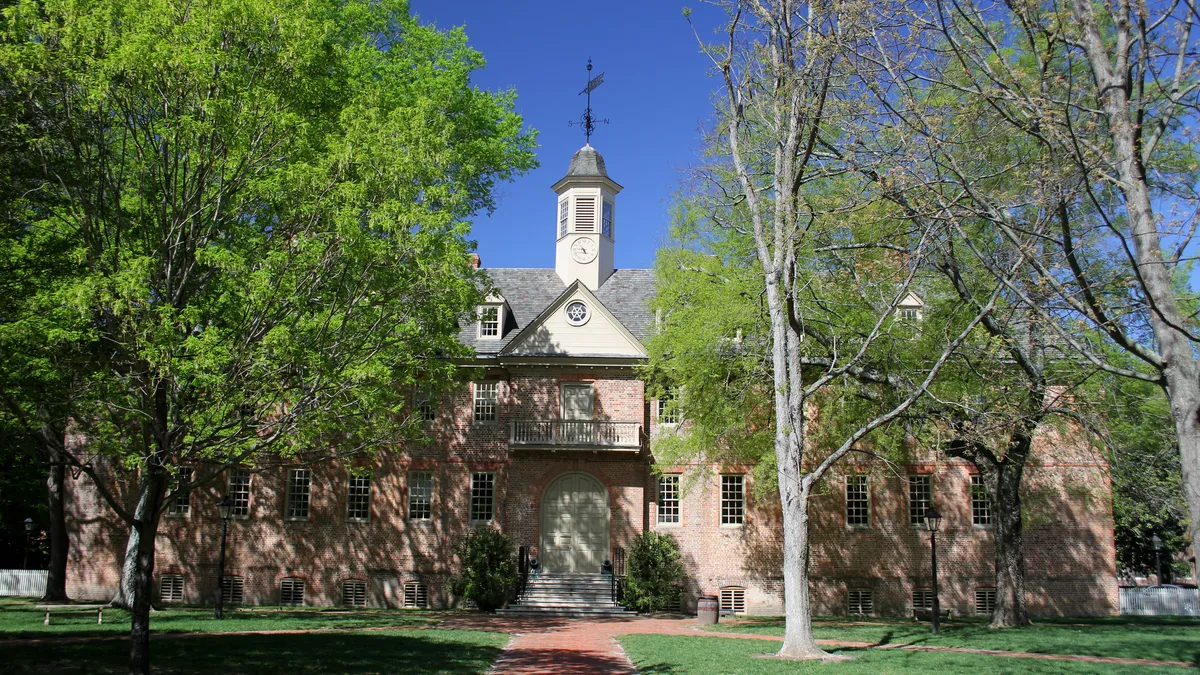Dive Brief:
- William & Mary last week announced two initiatives for students who receive federal Pell Grants, which are a proxy for low-income students.
- The public institution in Virginia will award enough scholarship funding to cover tuition and fees for in-state Pell-eligible undergraduates beginning in fall 2023. The policy will cover new, returning and transfer students alike.
- Leaders also plan to enroll larger shares of in-state undergraduates who are eligible for Pell Grants. They hope to increase the percentage from 17% today to 20% over the next four years.
Dive Insight:
William & Mary, which counts itself as the second-oldest higher ed institution in the country, has about 9,500 graduate and undergraduate students. It joins several other high-ranking colleges that have touted increased commitments to financial aid and low-income students in recent months amid amped up scrutiny of college affordability.
William & Mary plans to automatically provide extra scholarship funding to cover tuition and fees when the new program takes effect next year. It's also promising additional grant or scholarship aid for Pell-eligible students who demonstrate further financial need.
When announcing the effort Friday, leaders cast the move as part of growing attempts to enroll students who haven't traditionally attended college.
“This is a minimum, not a maximum guarantee,” Tim Wolfe, dean of admission, said in a statement. “The program announced today is part of a broad commitment to increase socio-economic diversity across campus and to continue supporting our students with financial need.”
William & Mary was already providing significant financial aid for Pell students. The average in-state Pell student received $28,000 in aid beyond the Pell Grant, which tops out at $6,895 this year.
But that could still leave a gap for low-income students. For in-state students, tuition, fees, room and board, and books and other expenses at the institution total almost $41,000 before financial aid.
William & Mary has enough funding in its budget to cover the new program's first year. After that, it's expected to cost $180,000 annually over three years.
Leaders estimate needing additional funding per class each year for increasing Pell-eligible enrollment.
Other competitive institutions have launched new affordability efforts in the last year. Dartmouth College replaced undergraduate loans with scholarships in June, Williams College eliminated loan and work requirements from its financial aid packages in April, and Whitman College said in May it will meet full demonstrated financial need for in-state students starting in fall 2023.
At the same time, policymakers have been increasingly scrutinizing college affordability. President Joe Biden's August decision to forgive large chunks of student loan debt set off a renewed debate about the cost of college. In Virginia, Gov. Glenn Youngkin, a Republican, has supported freezing tuition at public institutions, including during a February William & Mary convocation speech.
"I strongly urge our college and university boards to show restraint in tuition increases just as you have been doing during the pandemic," Youngkin said, according to a news release. "William & Mary has demonstrated real leadership in this area, finding efficiencies, working through collaboration and expanding partnerships to control costs. There are ways to grow universities without growing tuition."
William & Mary has kept tuition flat for in-state undergraduates for five consecutive years.














